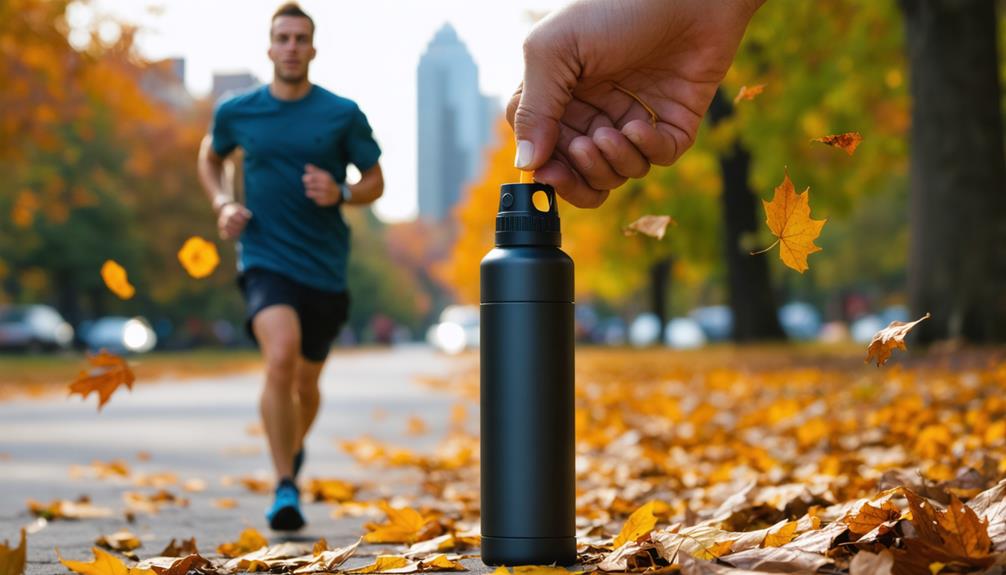
Brainstorm Security Shop

For Orders Over $199

On Any Of Our Products

Details On Refund Page
In today’s increasingly unpredictable world, runners face unique challenges when it comes to personal safety during their routines. While the benefits of physical activity are undeniable, the potential risks that accompany outdoor exercise cannot be overlooked. Pepper spray emerges as a practical solution, offering an added layer of security for those who value both their fitness and personal safety. However, the selection of the right product, understanding its effective use, and navigating the legal landscape are critical factors that demand careful consideration. What are the key elements to ensure pepper spray becomes a reliable companion rather than a liability?
Pepper spray serves as an effective self-defense tool for runners, offering a heightened sense of security during outdoor activities. The primary benefit of carrying pepper spray while running lies in its ability to incapacitate potential threats quickly, allowing individuals to escape dangerous situations.
As an integral component of self-defense techniques, pepper spray empowers runners with a portable means of protection, enabling them to respond rapidly in unpredictable circumstances.
The compact size of pepper spray makes it an ideal companion for those focused on personal safety. It can be easily carried in a pocket, on a keychain, or in a specially designed wristband, ensuring accessibility when needed most.
Unlike other self-defense methods that require close proximity or physical confrontation, pepper spray can be deployed from a safe distance—typically up to 10 feet—minimizing risk to the user.
Moreover, pepper spray is non-lethal, making it an appealing option for individuals wary of causing permanent harm. Its use can deter an aggressor effectively, providing crucial time for the runner to reach safety.
In a world where personal safety is paramount, incorporating pepper spray into a runner’s self-defense arsenal enhances confidence and peace of mind during outdoor exercises.
Selecting the appropriate pepper spray for runners involves considering several key factors to ensure optimal protection and convenience.
Firstly, evaluating product features is crucial. Look for pepper sprays that are lightweight, compact, and easy to carry, as these attributes are essential for runners who need to maintain agility and speed. Additionally, consider the spray’s range and potency; a longer range can provide a safer distance between you and a potential threat, while a higher potency ensures effectiveness.
Brand comparisons are equally important when choosing a pepper spray. Reputable brands often offer products that undergo rigorous testing for reliability and safety.
It is advisable to research different brands, read customer reviews, and perhaps even seek recommendations from fellow runners or self-defense experts. Some brands may offer unique features, such as UV dye for suspect identification or ergonomic designs for comfortable handling, which could be beneficial depending on your specific needs.

Effectively using pepper spray requires understanding and practicing a few essential techniques to ensure it serves its purpose during a critical moment.
Mastery of pepper spray techniques begins with familiarizing yourself with the device’s operation. Before heading out for a run, take the time to read the manufacturer’s instructions thoroughly. Practice removing the safety cap quickly and holding the canister properly, ensuring your thumb is on the bottom for better control and aim. This practice is crucial for effective deployment during a high-stress encounter.
A critical aspect of using pepper spray effectively is maintaining situational awareness. Runners should remain vigilant of their surroundings, keeping an eye out for potential threats. When deploying pepper spray, aim for the attacker’s face, specifically the eyes, to maximize disorientation and deterrence. A short burst of one to two seconds is usually sufficient.
Remember, wind conditions can affect the spray’s trajectory, so be mindful of wind direction to avoid self-contamination.
After deploying the pepper spray, create distance between yourself and the attacker. Use this opportunity to escape and seek help. Consistent practice and awareness are vital for ensuring that pepper spray serves as a reliable self-defense tool for runners.
When considering carrying pepper spray for personal protection while running, it is crucial to understand the legal implications in your area.
Awareness of local regulations, such as any age restrictions and specific locations where carrying pepper spray is permitted, ensures compliance with the law.
Being informed about these aspects not only helps in avoiding legal complications but also enhances the responsible use of pepper spray for safety purposes.
Understanding the legal landscape surrounding the use of pepper spray is crucial for runners who wish to incorporate it into their safety strategy. It is imperative to recognize that state laws and local ordinances can vary significantly, impacting the legality and conditions under which pepper spray can be carried and used. Some states impose restrictions on the size and concentration of pepper spray containers, while others may have broader regulations or even prohibit its use entirely.
Runners should be proactive in researching the specific laws applicable to their state and locality to ensure compliance and avoid potential legal repercussions.
Local ordinances can further complicate the legal framework governing pepper spray. Municipalities may have additional rules that override or supplement state regulations, and these can vary even within the same state. For instance, certain urban areas might have stricter controls to address safety concerns unique to densely populated environments.
To navigate these complexities, runners are advised to consult local law enforcement or legal resources to gain a comprehensive understanding of the regulations in their area. Being well-informed not only ensures legal compliance but also enhances personal safety by allowing runners to confidently carry and utilize pepper spray within the bounds of the law.
Age restrictions play a critical role in the legal considerations surrounding the possession and use of pepper spray by runners. These restrictions are often imposed to ensure that individuals who carry pepper spray possess the maturity and responsibility necessary to use it appropriately.
In many jurisdictions, youth restrictions are established, typically requiring individuals to be at least 18 years old to purchase or carry pepper spray. This age threshold aligns with broader legal standards that recognize adulthood as a period when individuals are presumed capable of making informed decisions about self-defense.
Furthermore, it is advisable for runners, particularly those near the age limit, to engage in self defense training. Such training not only instructs on the proper use of pepper spray but also emphasizes situational awareness and legal ramifications of its use.
Self defense training can enhance understanding of when and how to deploy pepper spray effectively, minimizing potential misuse and legal consequences.
Runners should be aware that age restrictions can vary significantly between states or countries. Compliance with these laws is essential to avoid legal repercussions.
Thus, understanding local legislation and obtaining appropriate training are fundamental steps for any runner considering carrying pepper spray for personal protection.
In addition to age restrictions, legal considerations for pepper spray extend to the locations where it can be lawfully carried. Jurisdictions vary widely in their regulations, and it is essential for runners to be aware of local laws governing the possession of pepper spray.
While some areas permit it in public spaces, others may impose restrictions, particularly in government buildings, schools, and certain private properties. Understanding these nuances is crucial to ensuring compliance and avoiding potential legal repercussions.
When considering carry styles, runners must select an option that aligns with both legal requirements and practicality. Popular carry styles include hand-held canisters, clip-on holsters, and wrist straps.
Each style offers unique advantages, such as ease of access or discretion, but also necessitates consideration of legal allowances in specific regions.
Storage options for pepper spray also demand attention. While some jurisdictions may permit open carry, others may require the device to be stored in a concealed manner.
Runners should ensure that their chosen carry style complies with local regulations, whether stored in a pocket, waistband, or specialized running gear. Awareness of these legal considerations facilitates responsible use and enhances personal safety.

When considering safety measures for runners, selecting routes that are well-lit and populated can significantly reduce the risk of encountering dangerous situations.
Equally important is maintaining a high level of alertness to one’s surroundings, which includes being aware of other people, traffic, and potential hazards.
Selecting a safe running route is essential for ensuring both enjoyment and security during your exercise routine. In urban environments, it is crucial to choose routes that are well-lit and frequented by other pedestrians. Busy streets with clear sidewalks can offer a safer alternative to secluded areas, minimizing the risk of unexpected encounters.
Additionally, scenic paths, such as those found in parks or along waterfronts, often provide a more pleasant running experience while maintaining visibility and accessibility. It is advisable to familiarize yourself with these areas during daylight hours to better understand their safety features and potential hazards.
When planning your route, consider the availability of emergency services or nearby facilities where you could seek assistance if needed. It’s also prudent to inform someone of your intended path and estimated time of return, especially when exploring new or less familiar routes.
Incorporating technology can enhance safety; smartphone apps allow you to share your location in real-time with trusted contacts. Furthermore, periodically varying your running routes can prevent predictability, ensuring that you are less vulnerable to potential threats.
Ultimately, selecting safe running routes involves a balance of awareness, preparation, and adaptability to maintain both enjoyment and security in your exercise routine.
While choosing a secure running route lays the foundation for a safe exercise routine, maintaining vigilance during your run is equally important. Awareness techniques play a crucial role in ensuring safety, particularly in environments that may present unforeseen challenges. Runners must develop a heightened sense of their surroundings to effectively respond to potential threats or hazards.
Environmental distractions, such as loud music or engaging in phone conversations, can significantly impair a runner’s ability to stay alert.
To enhance safety while running, consider the following strategies:
These awareness techniques can significantly enhance your safety while running.
Beyond pepper spray, considering alternative safety tools can enhance a runner’s sense of security. In an ever-evolving landscape of personal safety, equipping oneself with a variety of self defense techniques and personal safety gadgets can be invaluable.
Self defense classes, which teach skills such as how to break free from holds or deflect an attack, empower runners with the confidence and ability to respond effectively to potential threats. These techniques are not only practical but also serve to boost mental resilience in high-stress situations.
The market for personal safety gadgets has expanded, offering runners a range of innovative options. Wearable alarms, for instance, can emit a loud sound to deter attackers and attract attention. Some runners favor carrying compact stun guns, which can incapacitate a threat long enough for them to escape.
Additionally, GPS-enabled tracking devices are increasingly popular, allowing friends or family to monitor a runner’s location in real time, thus offering peace of mind.
Incorporating these tools and techniques into one’s routine not only broadens the arsenal available for self-protection but also reinforces a proactive approach to personal safety. For runners, being prepared can make all the difference.
Utilizing pepper spray during animal encounters while running can enhance personal safety. It serves as a non-lethal deterrent, providing individuals with a viable means of protection. Safety tips include carrying it accessible and understanding its effective usage.
To ensure optimal performance, pepper spray maintenance is crucial. Effectiveness testing should be conducted biannually, and the product should be replaced every two to four years, depending on the manufacturer’s guidelines and expiration date, to maintain reliability.
Accidental self-exposure to pepper spray may cause temporary blindness, respiratory distress, and skin irritation. Self-defense training should include first aid measures, such as rinsing with water and seeking medical attention, to mitigate these side effects effectively.
When considering the safety of carrying pepper spray in extreme temperatures, temperature effects on the spray’s efficacy and container integrity are crucial. Safety considerations include potential malfunction or leakage, impacting its reliability during critical situations.
When considering whether to carry pepper spray on international trips, it is essential to research legal regulations in the destination country. Compliance with local laws ensures travel safety and avoids potential legal complications during your journey.
Incorporating pepper spray into a runner’s safety strategy offers significant advantages, including enhanced personal security and increased confidence during outdoor activities. Selecting the appropriate product and mastering effective usage techniques are essential to maximize its benefits. Awareness of legal considerations ensures compliance with local regulations. Additionally, combining pepper spray with alternative safety tools provides a comprehensive approach to personal safety. By understanding and implementing these strategies, runners can better protect themselves against potential threats while maintaining focus on their fitness goals.
